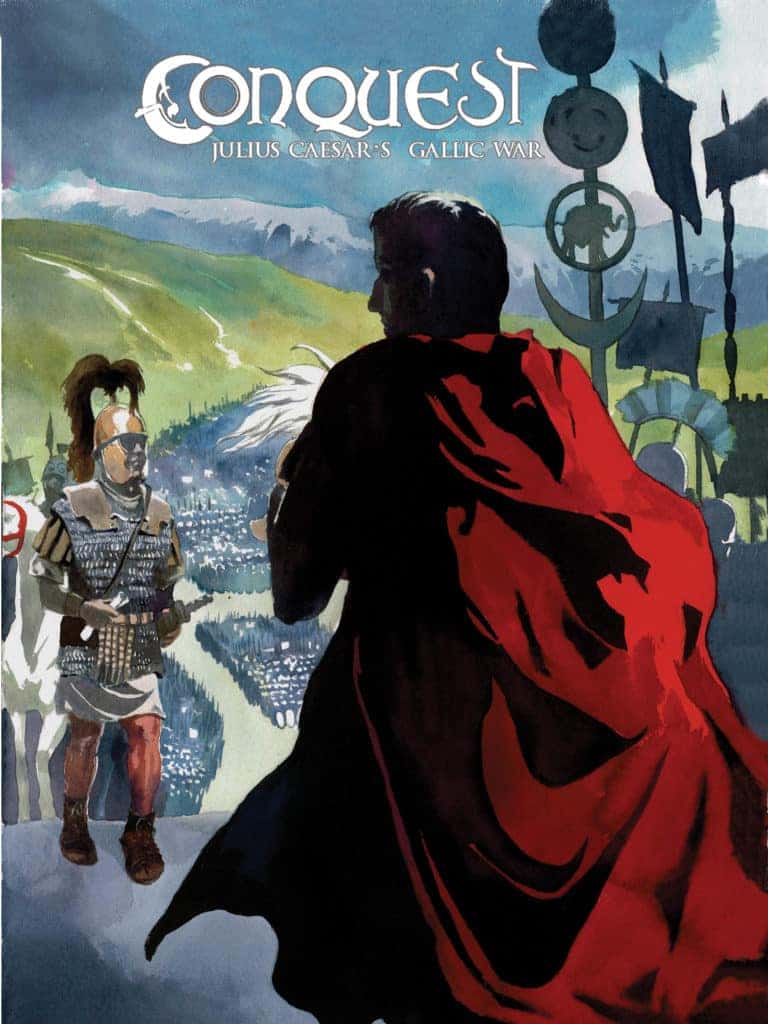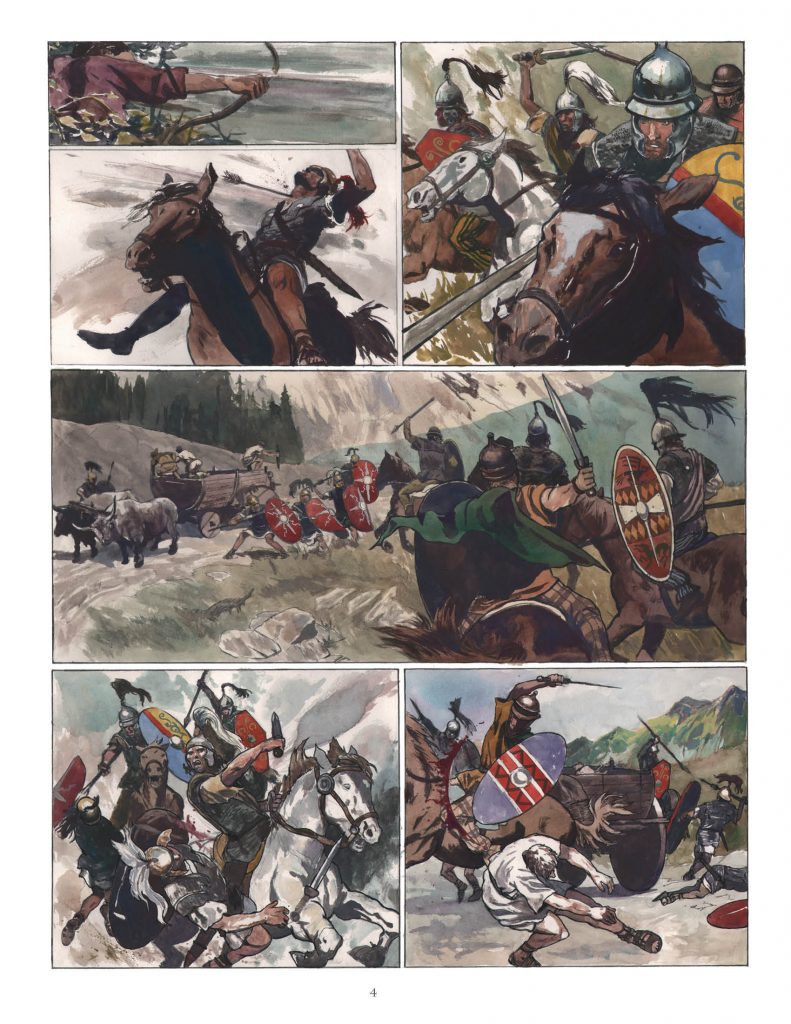Tarek Interview on his graphic novel, ‘Conquest: Julius Caesar’s Gallic Wars’
Tarek Ben Yakhlef is a Sorbonne (University Paris) graduate in medieval history and art history. Tarek launched “Paris Tonkar” in 1991, the first art book dedicated entirely to urban street art in Paris, which is still considered an important reference for urban art lovers.
Since 1999 Tarek has written more than sixty graphic novels with various publishers. His work has won several awards including the Saint-Michel Award for Best Screenplay for his graphic novel Sir Arthur Benton in 2007. Although his time is often balanced between photography, street art, and television, his interest inevitably returns to comics.
Tarek is the author and co-creator( alongside Vincent Pompetti – the artist) of the historical graphic novel, ‘Conquest: Julius Caesar’s Gallic Wars’.

Conquest: Julius Caesar’s Gallic Wars cover image.
Andrew Benteau, founder and publisher here at Black Panel Press, interviewed Tarek to gain exclusive insights into Julius Caesar’s graphic memoir. Here are some of the highlights of the interview:
- Tarek talks of his journey leading up to when he wrote Conquest: Julius Ceasar’s Gallic Wars.
- What is the link between urban art and graphic novels?
- What inspired Tarek to write this story?
- Tarek’s passion for history and Rome,
- The research behind the creation of Conquest: Julius Ceasar’s Gallic Wars.
- Why Tarek chose Vincent Pompetti to illustrate this graphic novel.
- The interesting discoveries of Roman history Tarek made while writing this story.
- How much of the book is factual history?
- What the story adds to our understanding of this period in time.
- Which parts of the graphic novel are purely fictitious?

Question 1: Could you tell us about your journey?
“My name is Tarek, the writer of Conquest: Julius Caesar’s Gallic Wars.
I started making graphic novels in 1999 with a science fiction story. Next, very quickly, I began writing stories for children, fairy tales, and stories oriented a little more toward history; notably about espionage during the Second World War. Rasputin
I started working with Vincent Pompetti in 2004. We started working together on Rasputin.
I started as a painter in the 1980’s and I am also the director of an art magazine. ”
Question 2: What is the link between urban art and graphic novels?
” Yes, there is a link that one might not imagine right away. Urban art is influenced very much by comics. especially regarding some of the more emblematic characters of comics. Urban artists collect many images from that world.
In the other direction, it’s less obvious. I would say there’s a few artists who make comics and we find an urban side a bit more in their work.
As for me, surprisingly, I rapidly divided up these two worlds. I’ve rarely used my work in urban art in comics or vice versa except maybe recently a painting series dedicated to pop art.
But otherwise, urban art and comics, there’s a link obviously.”
Question 3: Where did your desire to write this story come from?
” My first inspiration was my desire, since I was young, to write a story talking place in Rome, Gaul or Ancient Carthage.
With Vincent, since we’d already worked together on several projects, we discussed together and agreed that we wanted to work on the Republican period and the Gallic Wars seemed to us to be the obvious choice,
Plus the fact that Caesar’s commentary had never been adapted in comic form and for us, it was a double challenge. That of working on an emblematic text of accidental literature and trying to create a graphic novel from it.”
Question 4: Can you tell us more about your passion for history and Ancient Rome?
” The Mediterranian, with all that it includes from a historical point of view, I like to think that we’ve evolved from this society and we’re direct descendants from these ancient civilizations. Roman, Greek, Carthagen, Mesopotamian and Egyptian of course.
I’m also a historian by training so both of them are my life really. So I could say thwt history and comics together, which I take on often, is a part of me.
It’s like a background painting, more and more.”
Question 5: Have you done a lot of research for this story?
” Yes, we researched this story from two sides: Vincent’s and mine.
We worked a lot from the latest advances in archaeology concerning the habitat and the Roman and Gallic weapons.
We also worked a lot with re-enactment groups. We went to some sites where we could see some interesting things like Roman halls etc.
Research work is something that’s been with us for a long time because we are passionate, Vincent and I, by that period. So we really just deepened stories that we had already read or studied in our childhood.”
Question 6: Why did you choose Vincent Pompetti to illustrate this graphic novel?
” Vincent Pompetti is kind of my alter ego on one side. He’s also a virtuoso in painting.
And we had already worked together on Sir Arthur Benton, Rasputin and The Corsair.
As I mentioned earlier in the video, when we asked ourselves about the next graphic novel to do together, the subject seemed obvious to us and that’s it.
It’s very difficult to take on this subject with an artist who hasn’t already worked enormously on this subject out of love and who isn’t involved at a personal level because adapting The Gallic Wars isn’t an easy task.”
Question 7: Can you tell us about your working relationship with Vincent?
” We mutually consult each other about aspects that pose a problem to us. We conduct research from both sides; I bring certain elements to Vincent and vice versa.
Once I’ve written the text, he adapts it and transforms it to images. We really have a relationship of exchange but each one does his part, and that’s important. We each consider what the other wants.”
Question 8: Have you discovered anything interesting while writing this story?
” Yes, while researching this story, we realized that many of the cliches and stereotypical images that we associated with either the Romans or Gallic were actually false.
We also discovered that the Celts, because “Gallic” was the Roman word for the Celts. The Celts had, from the point of view of weaponry, metallurgy and combat techniques, levels of excellence worthy of the Romans so the Romans copied them in many areas.
Afterwards, our biggest worry was explaining that Vercubgetorix was first an ally of Caesar throughout the war and he only becomes, at the end of the war, his enemy.
This was perhaps the most difficult aspect to communicate to people. Because it’s something we know among historians and people who’ve worked on this subject. But the majority of people still think that Vercingoterix was the great defender of Gaul from the beginning which isn’t the case.”
Question 9: How much of the story is based on reality?
” Reality…… is always evolving. Suffice to say that research proves that we’ve advanced and it modifies reality and thus reality becomes a new reality.
I would say that our text is very close to reality. It’s so close that the re-enactment groups whom we’ve met were sometimes dressed or carried weapons similar to those found in our graphic novel. “
Question 10: What does this story add to our understanding of this period in time?
” It’s a way to re-live and to dive into the beginning of Roman society because Caesar is the figure who changed the face of history of the Mediterranean and Europe.
It allows non-historians and people not familiar with this period to discover or re-discover an extremely important moment in history.
Even more so than the one we’re in now where people are asking themselves about the different ways of governing.
Caesar, in all respects, the person who has introduced many types of governing which we’ll discover and explore throughout the events that follow.”
Question 11: Which parts of the story are fiction?
“If you look we’ve created an adaptation that is very close to the original text.
But we also introduced a fair number of fictitious characters to create links between the diverse accounts of Caesar.
I would say that about 85% of the story is based on historical accounts and links back to the original text and the remaining 15% is fiction introduced into the historical text. But it’s fiction that could have been true. So we paid attention to ensure that all of the fictitious characters who appeared were incredible and when we show real characters in moments where they never actually appeared.
We show them during moments when Caesar didn’t write or left gaps in certain passages of his writing.”
Conquest: Julius Caesar’s Gallic Wars is set for a reprint to drop in February 2024. Subscribe to our email newsletter to get updated when the reprint is available.

Do you love free graphic novels?
1. Sign up with your name and email address.
2. Fill out a short survey.
3. Check your inbox for your free graphic novel.
You have Successfully Subscribed!